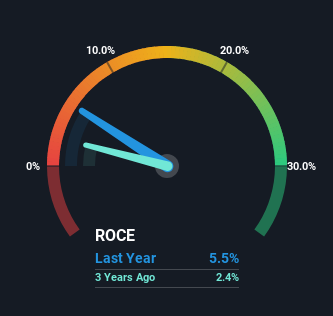- Australia
- /
- Commercial Services
- /
- ASX:DOW
Investors Met With Slowing Returns on Capital At Downer EDI (ASX:DOW)
If we want to find a potential multi-bagger, often there are underlying trends that can provide clues. Firstly, we'll want to see a proven return on capital employed (ROCE) that is increasing, and secondly, an expanding base of capital employed. If you see this, it typically means it's a company with a great business model and plenty of profitable reinvestment opportunities. Having said that, from a first glance at Downer EDI (ASX:DOW) we aren't jumping out of our chairs at how returns are trending, but let's have a deeper look.
Return On Capital Employed (ROCE): What Is It?
For those that aren't sure what ROCE is, it measures the amount of pre-tax profits a company can generate from the capital employed in its business. To calculate this metric for Downer EDI, this is the formula:
Return on Capital Employed = Earnings Before Interest and Tax (EBIT) ÷ (Total Assets - Current Liabilities)
0.055 = AU$223m ÷ (AU$6.6b - AU$2.5b) (Based on the trailing twelve months to December 2023).
So, Downer EDI has an ROCE of 5.5%. In absolute terms, that's a low return and it also under-performs the Commercial Services industry average of 12%.
View our latest analysis for Downer EDI

In the above chart we have measured Downer EDI's prior ROCE against its prior performance, but the future is arguably more important. If you're interested, you can view the analysts predictions in our free analyst report for Downer EDI .
The Trend Of ROCE
Over the past five years, Downer EDI's ROCE and capital employed have both remained mostly flat. Businesses with these traits tend to be mature and steady operations because they're past the growth phase. So unless we see a substantial change at Downer EDI in terms of ROCE and additional investments being made, we wouldn't hold our breath on it being a multi-bagger. That being the case, it makes sense that Downer EDI has been paying out 64% of its earnings to its shareholders. Most shareholders probably know this and own the stock for its dividend.
The Bottom Line
In a nutshell, Downer EDI has been trudging along with the same returns from the same amount of capital over the last five years. Since the stock has declined 31% over the last five years, investors may not be too optimistic on this trend improving either. In any case, the stock doesn't have these traits of a multi-bagger discussed above, so if that's what you're looking for, we think you'd have more luck elsewhere.
Downer EDI does have some risks though, and we've spotted 1 warning sign for Downer EDI that you might be interested in.
While Downer EDI may not currently earn the highest returns, we've compiled a list of companies that currently earn more than 25% return on equity. Check out this free list here.
New: Manage All Your Stock Portfolios in One Place
We've created the ultimate portfolio companion for stock investors, and it's free.
• Connect an unlimited number of Portfolios and see your total in one currency
• Be alerted to new Warning Signs or Risks via email or mobile
• Track the Fair Value of your stocks
Have feedback on this article? Concerned about the content? Get in touch with us directly. Alternatively, email editorial-team (at) simplywallst.com.
This article by Simply Wall St is general in nature. We provide commentary based on historical data and analyst forecasts only using an unbiased methodology and our articles are not intended to be financial advice. It does not constitute a recommendation to buy or sell any stock, and does not take account of your objectives, or your financial situation. We aim to bring you long-term focused analysis driven by fundamental data. Note that our analysis may not factor in the latest price-sensitive company announcements or qualitative material. Simply Wall St has no position in any stocks mentioned.
About ASX:DOW
Downer EDI
Operates as an integrated facilities management services provider in Australia, New Zealand, and internationally.
Excellent balance sheet with proven track record.
Similar Companies
Market Insights
Community Narratives




